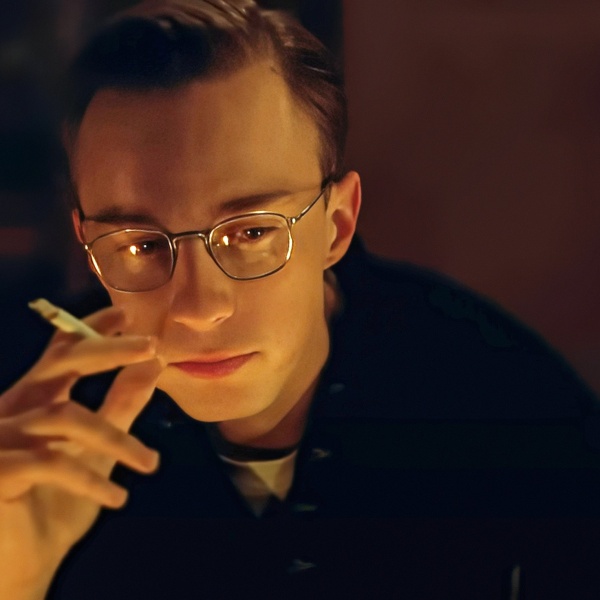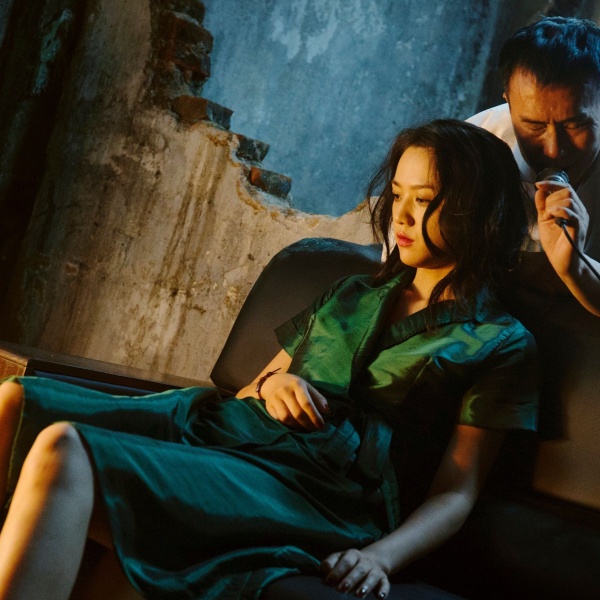An empathy-for-all approach to a queer revenge thriller about the attraction that forms between a Black drag queen and his white attacker after a homophobic assault? That’s the slippery thrust of queer British filmmakers Sam H. Freeman and Ng Choon Ping’s “Femme,” starring Nathan Stewart-Jarrett and George MacKay as East Londoners who share a perverse romantic connection founded on revenge. It’s a movie in revenge noir drag of its own, concealing a sinister love story.
As “Femme” begins, Jules (Stewart-Jarrett, the British actor known for his roles in TV’s “Misfits” and “Culprits”) is coming off the high of another fabulous performance under the drag persona Aphrodite Banks. Still in full garb, he stops at a convenience store where he’s at first cruised by Preston (MacKay, the rising star who proved himself in Best Picture nominee “1917”), a tatted-up criminal cutting an alluring figure under a streetlamp. But Preston soon after brutally beats Jules to impress his rabbling macho band of friends, leaving Jules naked and collapsed in the street.
But cut to some time later, and the movie gets trickier. After seeing his attacker in a bathhouse, Stewart-Jarrett’s traumatized Jules at once wants to seduce and destroy George MacKay‘s inked and closeted Preston by outing his assailant after the attack. But in the process, Jules develops empathy and possibly love for Preston even in the entrapment. Meanwhile, Preston doesn’t recognize his own victim, now out of drag and too scarred to return to it, and his own feelings grow, too. What “Femme” — part neo-noir thriller, Greek revenge opera, and convincingly perverse romance all wrapped up in one — will leave you with is an unsettled feeling about who is truly good or evil. A rare feat for a film whose starting point is a violent assault as disturbingly familiar to queer people as the Stockholm syndrome-like feelings we might feel toward our own bullies.
Freeman and Ng, first housemates who bonded over movies and video games before becoming longtime friends, originally conceived “Femme” as a BAFTA-nominated 2021 short starring Paapa Essiedu and Harris Dickinson as Jules and Preston. “The seed of the idea came from this frustration about feeling that, as queer storytellers, we didn’t have access to genre. In a blunt, seed-of-the-idea way, we love neo-noir, late-night crime thrillers,” Freeman told IndieWire over Zoom. “We were watching ‘Good Time,’ the Safdie Brothers, classic Scorsese movies, and sort of feeling like, ‘We love this, but we feel like we wouldn’t be allowed into this club ourselves.’”

“In making the short, which is one night, we realized we wanted to tell a bigger story that requires more nights,” said Ng, the co-director/writer whose feature-length version unfolds almost entirely in the dark against the neons of London’s underground nightlife, at drag shows, in cruisey steam rooms. MacKay’s Preston lives behind a screen of performed machismo; Stewart-Jarrett’s Jules, meanwhile, is out and proud, his gender identity performed on- and off-stage lived-in, confidently.
For Ng, “Femme” “interrogates the performance of gender” of all kinds, not only with Jules in drag but also Preston’s own “drag” as a straight-presenting closeted street criminal, which MacKay embodies in a physically transformed turn involving hours in the makeup chair and at the gym.
“Preston and his gang perform a kind of masculinity that is important in their world, to maintain power, to establish hierarchy,” Ng said. “A plot of the film is about Jules exchanging one performance of gender for another in order to infiltrate that alien world [belonging to Preston], to exact revenge. That is kind of a constellation of ideas we were playing with, with a drag queen protagonist, with the title ‘Femme,’ and in fact, we kind of see Preston as a drag king in the way he has to be extra loud in all the semiotics of a certain type of masculinity.”
No Black and White
The actors, now dear friends who shot “Femme” on location in London in June 2022, were drawn to the film’s lack of easy morals, and how both characters are performing gender and sexuality in their way.
“The film doesn’t present any person as entirely good or bad,” Stewart-Jarrett said. “Arguably, there is good and evil, we know that, but most, if not all of us, have a degree of both of those things within us. I do think that Jules is a victim in the beginning. He doesn’t compromise that but basically does something to reclaim his independence and agency that isn’t probably the best thing to do and so, therefore, is not a victim throughout the entire movie.”
“The older I get, the grayer the world gets,” MacKay said. “Things are quite polarized in a minute. There are so often things that should be talked about, and I don’t think that’s the case. It’s great to have a film that reflects that in the arcs and the characters involved.”
“We didn’t want to create a black-and-white, binary, moralistic movie,” Freeman said. “We wanted to explore the humanity of all the characters on screen. We were creating a story where that’s difficult to do. We were putting ourselves into the perspective of someone, [who] in real life, is a kind of person we are quite scared of, an anxiety we carry around in the street, that we might meet a Preston… We wanted to ask questions instead of make statements. We wanted to go, ‘Here’s what we think the world is, and it’s tricky and messy,’ and we wanted to present it in a way that means you leave the theater questioning it.”

Transforming into Drag
MacKay and Stewart-Jarrett both took upon themselves physical reinventions to portray the roles, with Stewart-Jarrett prepping in heels on a treadmill to gear up to play a drag queen, and MacKay muscling up to play a closet case chafing under his own skin. They’re an unlikely duo in the flush of first love, which means, of course, a lot of sex.
“Despite whatever tactics or reasons behind the sex they have, if your body is doing something, it’s telling you something,” MacKay said. “There’s the mixture of the cerebral identity, the thought, the feelings, and then something physically, if your body tells you something, you can’t remove yourself from that. So I thought physically being stronger, scarier, tougher as Preston was essential. Working with Buki [Ebiesuwa], our costume designer, and Marie [Deehan], our makeup designer, both of them with their initial thoughts expanded my idea of how to push this.”
But for MacKay, Preston was a role quite outside his element. “There was a level of self-consciousness,” he said. “This is not my world. I know men from equivalent places and energies, but I’m not Preston, so I was self-conscious about overdoing it. But actually, no, this is about drag, and the more I pushed it, the more natural it felt to swagger in that way with those clothes, the jewels, and the hand tattoos. Frankly, it also does so much work for you.”
Meanwhile, for Jules to become his stage persona Aphrodite Banks, the filmmakers and Stewart-Jarrett worked with Jonbers Blonde, a Northern Irish drag queen from Season 4 of “RuPaul’s Drag Race UK” as a consultant. But that never meant sticking to one particular idea of drag — a notion the movie itself flouts.
“I had done drag in a play before [‘Wig Out’ at the Royal Court in London], which was an entirely different experience. That character had to get out of drag to win their love, so it was the same kind of thing. I didn’t really want to look at drag queens per se because I think drag is an expression of someone’s inner life and their view or take on art. I looked at Nicki Minaj and anime,” Stewart-Jarrett said in terms of inspirations for the look, who is only seen in drag at the beginning and end of the film — significant for the character’s arc.

For Stewart-Jarrett, becoming Jules out of drag also meant transforming his own physique after beefing himself up for Hulu’s “Culprits,” the heist series in which he plays a former bodyguard.
“I’d just finished ‘Culprits’ for Hulu like three weeks before, and so I was kind of stacked. Nine, eight months eating six eggs a day and god knows what,” Stewart-Jarrett said. “I was far too big to play the part. I went on holiday to Italy, and Buki had given me these heels to practice in that were really fucking high. I just kind of was the guy on holiday in Italy trying to lose weight avoiding pasta and not eating all the wonderful food. In the first scene, I can see a massive difference to the end in my physique. I was losing weight throughout the whole film because I only had three weeks to share all this muscle.”
MacKay chimed in: “The audition we did together, genuinely, Nathan was like a linebacker, with the pads. It was extraordinary. I was really intimidated. I was trying to be scary as well, and I was tiny. Nathan slimmed down, and thank god.”
But directors Freeman and Ng didn’t mandate any kind of physical makeovers — it was about the actors discovering who the characters were on the outside for themselves.
“We gave them quite a lot of freedom,” Freeman said. “We wanted them to bring something personal to that: This is my drag queen, my drag king. George has spoken so much about the hair and makeup particularly, working with Marie on those tattoos. That neck tattoo, in the beginning, on the page was something quite small, something that Jules would be able to recognize him by. When I look back on that, I always think, why did he need a neck tattoo to be recognized? He has a face!”
“It was because we were talking about how in the gay sauna, it might be quite dark,” Ng said, noting the decision to embroider MacKay with tattoos that, in movie makeup tradition, only lasted three days before they had to be reapplied.
“When George and Marie came to work on those tattoos, they went bigger and bigger on it. For him, this idea of someone who is trying too hard, who is really putting it on, was really helpful for him,” Freeman said.

Sex and Violence
Don’t doubt that “Femme” isn’t a twistedly romantic movie beneath its own revenge thriller drag. As Jules and Preston solidify a very real attraction, underneath that is Jules’ plot to out Preston by leaking an iPhone-made sex tape of them. The sex scenes throughout, beginning as hasty fucks in the backseat of Preston’s car, become increasingly tender as their obvious, palpable romance forms — and the violence more brutal, as “Femme” is bookended by two assaults that demanded intense and focused choreography from the actors on set.
Scenes of violence were approached “much the same way that we approached the choreography of the sex scenes,” Stewart-Jarrett said. “I only had a framework, and within the framework for both the sex scenes and the fight scenes, we had to trust each other … and feel free to bounce around within that. The fight scenes were, in a weird way, more choreographed.”
Stewart-Jarrett and MacKay worked with both intimacy and stunt coordinators on the film, and both the fight scenes and sex scenes “tell the journey of us,” MacKay said. “By the time we got to the fight, we’d done most of the sex, and therefore had a kind of clearer journey of almost subliminally trying to choreograph.”
As this was an independent shoot on limited time and means (produced in part by BBC Films), MacKay didn’t necessarily have time to do any prior field work in portraying the repressed Preston, who lurks in bathhouses and on Grindr. “It became about building a mental picture of Preston’s world growing up, and his particular repression came about between the idea of a particular working-class East London background, beyond what’s cool in East London … those areas where you’re middling in between stuff. I don’t want to be unfair to those places, but there’s just not room for the type of man that perhaps he could have blossomed into if he didn’t grow up where he did.”
But there is room in “Femme” to question the right and wrong of it all in a story that, on its surface, looks like a traditional revenge thriller before unfurling into something much darker and deeper that raises questions about the spaces that form between attacker and victim.
“For my taste, the best stories [are] where there is a hero pursuing a villain, and the hero becomes obsessed with the villain and vice versa,” co-director/writer Ng said. “They keep encountering each other and absorbing parts of one another. This revenge relationship pulls them closer together. In some of the stories, it might become an obsessive friendship, but in this particular case, it becomes a perverse, dark romance that really helps us tell the complicated morality that underlies revenge.”
“Femme” is now in select theaters from Utopia.




